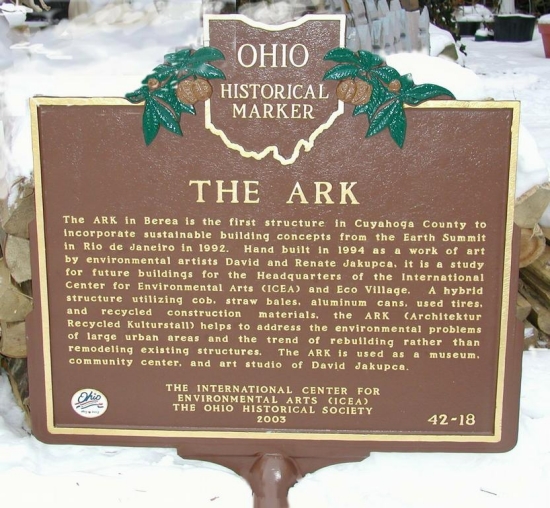
"ARK in BEREA Eco-Museum"
The historic home and museum of
American Cultural Ambassadors David and Renate Jakupca.
Summary: A.R.K. stands for - Architektur Recycled Kulturstall.
The historic A.R.K. in Berea Eco-Museum is the first structure in Cuyahoga County, Ohio to incorporate sustainable building concepts from the Earth Summit in Rio de Janeiro in 1992. Hand built in 1994 as a work of art by Environmental Artists David and Renate Jakupca. It is a practical design study for the 'Theory of Iceality in Environmental Arts' for future buildings and for the global headquarters of the International Center for Environmental Arts (ICEA) and Cleveland’s Eco Village. It is also a pioneer structure for the Leadership in Energy and Environmental Design (LEED) Certification developed by the U.S. Green Building Council (USGBC) in 1998.
The A.R.K. is hybrid structure utilizing cob, straw bales, aluminum cans, used tires, and recycled construction materials, It helped to address the environmental problems through 'iceality' of large urban areas and the trend of remodeling rather than demolishing and rebuilding existing structures. The ARK in Berea Eco-Museum is used as an eco-museum, community center, and art studio of American Cultural Ambassadors David and Renate Jakupca. It is recognized as the 'Birthplace of the sustainable Environmental Art Movement and is registered with the Berea Historical Society, Western Reserve Historical Society and the Ohio Historical Society.
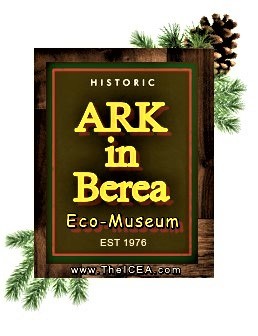
The ARK in Berea Eco-Museum is a project of the International Center for Environmental Arts (ICEA) and was an extension for the Habitat II Conference which was held in Istanbul, Turkey June 1996. It is a practical study on original sustainable building designs and ideas that will be used on ICEA’s permanent HQ building that anchor the complete Cleveland Eco Village on Whiskey Island near the mouth of the Cuyahoga River in the flats of Cleveland, Ohio. The ARK in Berea as a hybrid structure is composed of four material building techniques now being used on a limited basis worldwide. The key to such a hybrid structure is that it combines a thermal mass technique, such as rammed earth on the east wall, with an isolative system of straw bales and straw clay on the north and south sides, taking advantage of the best qualities of each system.
New solutions to common problems have begun to evolve from such creative combinations. The key to the ARK in Berea’s natural, yet subtly elegant design, was knowing when and where to incorporate techniques that would result in increased building efficiency, structural innovation and unique artistic effects.
As the ‘Spiritual Father of the Environmental Arts Movement’ and founder of ICEA, David Jakupca wanted the ARK in Berea Eco-Museum to stand out as an artist’s building. ICEA, whose mission is ICEAlity, that is to assist an understanding of the relationships between Humans and their Environment through the Arts, it was imperative that the ARK in Berea have a distinctive aesthetic appeal while simultaneously actually helping the environment.
Construction on the ARK in Berea Eco-Museum started out slow in 1993. Being built partly underground on the side of the valley, all excavating and construction had to be done by hand making the ARK in Berea Eco-Museum truly a hand made piece of art, complete with date and signatures of the artists! In the beginning, an unseasonably wet winter contributed to heavy mud slides before retaining walls could be built. David found by trial and error some things worked and some did not. The one idea that did work was to build a solid foundation in the front and tunnel backward when time and weather permitted.
The front (west wall) is made of recycled materials. Aluminum cans were cemented on pallets for walls and glass doors became picture windows. Old cedar shingles were one of the Jakupca’s great found treasures. A volunteer of ICEA, Marty Lane, knew about the shingles that were about to be transported to the dump after a re-roofing job. They talked to the construction foreman and he was happy to drop a couple truck loads to their site.
The ARK in Berea Eco-Museum proved that incorporating salvaged, recycled and resourceful materials invites an innovative style that is easier on the environment but adds character from different woods and products not readily available anymore. “In Cleveland, as in most cities, the trend is to rebuild rather than remodel and with all that waste in demolition -- there must be a way we can use that,” David says.
Moving backward from the front wall, the primary building material is Leichtlehm (literally light-loam) which is a German technique of ramming loose straw coated with a clay slip into forms as an infill for timber frame structures. The technique consists of surrounding a from structure with a thick infill of the straw-clay mixture. The frame is usually fully expressed on the interior of the building to take advantage of the beauty of the timber from joinery. A lighter frame of wood is built on the eventual outside face of the building as an anchoring system for the straw-clay walls.
At the back of the ARK in Berea Eco-Museum is a 2’ x 6’ ditch or tub to control and collect mud and water run-off. Loose straw and clay slurry are mixed in the tub then allowed to age for up to several days in order for the straw to absorb the extra moisture and thus create a stickier and more easily tamped mixture. For higher insulation values, less clay was used. Slip forms were set up between the framing members, and the straw clay mixture is tamped by hand or foot. During heavy rains the tub was bailed before it overflows inside.
Robert Laporte, timber farmer and straw-clay builder, commonly uses straw-clay stuffed loosely between rafters as insulation, with the clay discouraging pests. He has also used it as an insulting layer underneath earthen floors. Frank Andresen, German expert on straw-clay, has demonstrated a system of straw-clay tiles which can be placed between roof rafters as insulation and as a plastering surface. He has also introduced straw-clay bricks that can be used like light-weight adobes.
The ARK in Berea Eco-Museum over time evolved into a structure that inspires others while it echoes in rhythm with the river and woods that surround it. High on a ridge overlooking the pristine Rocky River in Northern Ohio, in the morning, when the mist is lifting its curtain of gauze from the valley below, deer move silently along the shore and Canadian geese fly inches above the water honking wildly before rising noisily skyward. A comfortable space that works with nature, not stomps on it. This is a community of people who want to explore the challenge of living in ways that are materially sufficient, socially and ecologically responsible, and satisfying to the soul. Since 1973, the Jakupca's have developed the skills of community: sharing, responsibility, compassion, communication, consensus building, conflict resolution, appreciation of diversity, love through iceality. They believe that these skills are necessary to bring the larger society to sustainability and sufficiency, and they have shared to the best of their ability.
ICEA’s reputation as an avant-garde cultural center for the elite continues to grow, drawing the likes of sculptor John Puskas, adventurer poet Daniel Thompson, activists Ione Biggs, and environmentalists John Perera, as well as other members of the international community, over time making ICEA a force for socially responsible activity.
The ICEA has in its library books, videos, manuals, etc. related to natural building methods. People interest in ICEAlity or the Cleveland Eco Village concept are invited to attend the next informal pot luck meeting at the ARK in Eco-Museum. Please call (440) 891-8376 for details.
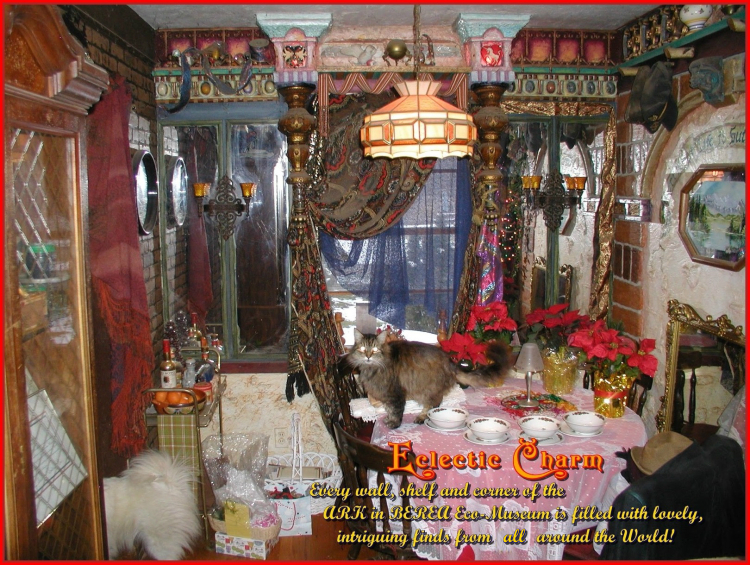
Avid Global Travelers, Ambassadors David and Renate Jakupca,
Love to Find Beauty and Peace Everywhere in the World
https://https://wp.me/p42V70-9j
The place that is impressive is the iconic ARK in Eco-Museum, where the Jakupca's live and where they invited me to party's and to view their lives in action. David created this sustainable future showplace for the couturiers that caused a sensation when it debuted. In 1994 it appeared on the cover of the Plain Dealers HOME MAGAZINE, the areas prestigious journal."
"It was boule de neige - and it snowballed from there." It was all new what the Jakupca's were doing then.....and what they still do." David is very innovative. Because of his style, he did things in the ARK in Berea Eco-Museum that were truly workable long before anybody else did. He used recycled materials when they were not fashionable then. He was very ahead of his time. "The Jakupca taste is not for everyone. The Jakupca's are only interested in their taste: they are sure of what they want and what they have is the best - not just commercially made objects but genuine Art...the ARK in Berea Eco-Museum is probably the only place in the world that has Egg & Cove molding made with real eggs!
Today, internationally, many of the new robber barons try to emulate the Jakupca Look in their houses. A Big Mistake. Today, everyone wants to be green and earth friendly. Only the Jakupca's can do Jakupca's Style... and it looks ridiculous when others try to do it, especially in modern their prefab gated communities. Attempts to copy this look entails a lot of 'cheating' without the necessary courage of originality...it is awful. But that is was makes the ARK in Berea Eco-Museum unique. Written by Eugene Schiopota
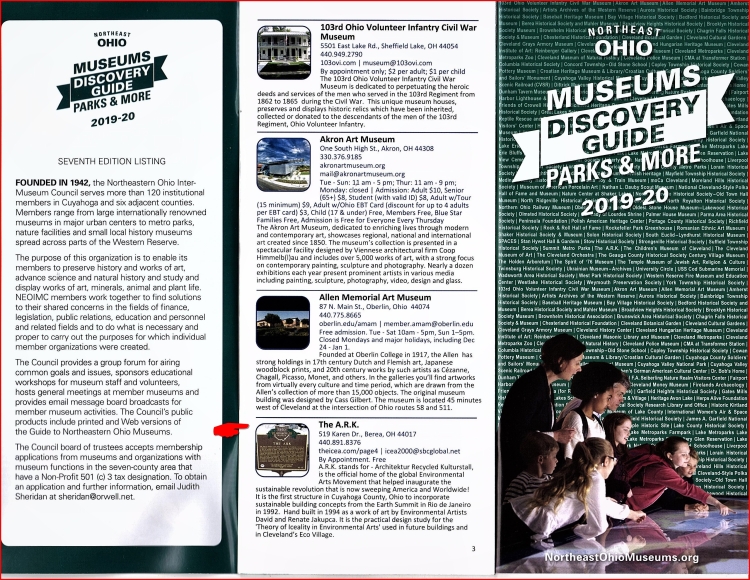
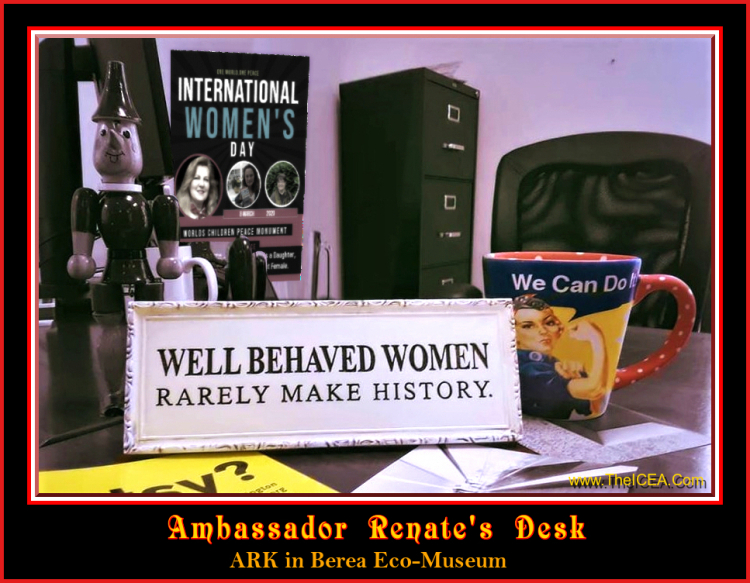
Related Links on the WEB:
The Beginning of Greater Cleveland's Sustainable Movement can be traced to a rustic community fire pit at the ARK in Berea, Ohio.
https://bereabuzz.blogspot.com/2013/10/beginning-of-north-east-ohios.html
The Living Green Walls at the ARK in Eco-Museum
https://bereabuzz.blogspot.com/2009/08/living-green-walls-at-ark-in-berea.html
Berea Artist's Yard a Work of Art
https://bereabuzz.blogspot.com/2009/07/berea-artists-yard-work-of-art.htmlhttps://bereabuzz.blogspot.com/2009/07/berea-artists-yard-work-of-art.html
Yard Work and the ARK in Berea Eco-Museum- ICEAlity as viewed from Heaven.
https://bereabuzz.blogspot.com/2008/11/yard-work-and-ark-in-berea-as-viewed.html

~~~~
Hundertwasser the famous architect, designer and artist wrote, "The individual's desire to build something should not be deterred! Everyone should be able and have to build and thus be truly responsible for the four walls in which he lives".
Jon Jandai, Director of Pun Pun Organic Farm said presentation in Thailand,
 |
"I want to be equal to animals. The bird makes a nest in one or two days; the rat digs a hole in one night, but clever humans like us spend 30 years to have a house... that's wrong." |
Reference/Educational Link:
ARK in Berea Eco-Museum
https://wikibin.org/articles/ark-in-berea.html
David Jakupca/ARK in Eco-Museum
https://bereabuzz.blogspot.com/2013/02/who-is-spritual-father-of-environmental.html
Global Ecovillage Network
https://gen.ecovillage.org/
Gaia Education programmes
https://www.gaiaeducation.net/index.php/en/
Natural Homes
https://naturalhomes.org/
Museums… So What?
https://medium.com/code-words-technology-and-theory-in-the-museum/museums-so-what-7b4594e72283

